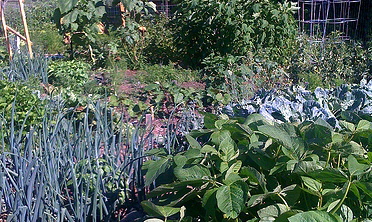Natural Pest Control
Our gardens, both crop and flower gardens, provide a buffet for pests in one consolidated feasting area. Companion Planting can help reduce insect pest problems.
When we plant our gardens we are concentrating all the garden pests favorite foods in a compact area. The insect pests can feast all season and barely have to move. Organizing our planting a little differently can help make it a little less inviting for the pests. Companion planting has long been utilized to take advantage of certain plants natural properties that deter pests. Interplanting flowers and herbs with vegetables can help attract beneficial insects where they are most needed. And when we do have an insect pest problem that is out of control, there are natural and organic remedies that can help.
Surely you have heard gardeners say things like ”roses love garlic”. There really is some science behind much of what you might think of as garden lore. Research does exist to prove that certain plants produce compounds that repel certain pests or that attract pest predators, our beneficial insects. And some of the plant combinations even improve production and flavor for each other.
Plants that repel insect pest:
Catnip repels squash bugs, Japanese Beetles, weevils, ants and aphids.
Chives and alliums such as onion and garlic repel ants, aphids, Japanese Beetles, carrot rust flies and flea beetles.
Coriander repels aphids
Dill repels aphids, spider mites and squash bugs. It also attracts the beneficial insects hoverflies and predatory wasps.
Garlic repels aphids and Japanese Beetles if planted near roses and raspberries. It also repels carrot root fly, root maggots and snails.
Rosemary and sage repel cabbage moths and carrot flies
Oregano repels cabbage moth
Basil repels flies and mosquitoes
Basil repels tomato pests
Borage repels tomato horn worm and cabbage moths
Mint repels cabbage moths, flea beetle and ants
Parsley repels asparagus beetles and carrot rust fly
Catmint produces an insect repellent. Steep it in water to spray on plants to repel flea beetle.
Radishes repel cucumber beetles
Potatoes and beans grown near each other, but not interplanted, will protect each other. The potatoes repel Mexican bean beetle and the beans repel Colorado potato beetles
Artemesia produces an antiseptic that repels most insects.
Dahlias repel nematodes
Four O-Clocks are poisonous and Japanese Beetles love to eat them!
French Marigolds repel whiteflies, tomato hornworms, bean beetles, cucumber beetles, nematodes and and asparagus beetles
Pot Marigolds repel asparagus beetle
Hyssop repels cabbage moths
Nasturtium repels squash bugs, aphids, cucumber beetles, been beetles and whiteflies
Petunias repel asparagus beetles, leafhoppers, aphids, and tomato worms.
Rue and white geraniums repel Japanese Beetles
Tansy repels ant
Companion Plants and Interplanting:
Companion plants should be planted alongside or near each other. Plants for interplanting can be distributed throughout your garden to benefit all your plants. There is a lot more to companion than indicated here, these are only companions that will assist with pest control.
Basil improves production and flavor for tomatoes and peppers.
Borage is a great companion to many garden vegetables, especially tomatoes and cabbage for pest repellent but also benefits strawberries.
Chamomile improves flavor for brassicas including cabbage and cucumbers. It also attracts beneficial insects.
Catnip should be planted near squash and cucumbers to repel squash bugs and aphids.
Dill improves flavor for brassicas including cabbage and cucumbers as well as generally repelling pests. But do not plant dill alongside tomatoes.
Onions are great companions in particular to cabbage, broccoli, tomatoes, strawberries, peppers, and cucumbers. Onions can be interplanted throughout the garden.
Radishes planted with cucumbers will repel cucumber beetles and can be interplanted.
Radishes are a great companion to spinach. Leafminers will eat radish leaves rather than the spinach.
Tomatoes are great companions to asparagus. Solanine in tomatoes protect against asparagus beetles.
Marigolds can be interplanted to deter nematodes and insect pests.
Nasturtiums are a great companion to tomatoes, cucumbers and cabbage. Interplant nasturtiums throughout your garden to repel pests.
Sunflowers can be interplanted as a trap crop for pests including aphids.
When natural planting methods are not enough, at the very least we can try to protect the environment from the damaging and residual effects of chemical pesticides by using organic pest control solutions
You have done what you can to prevent pests by attracting beneficial insects and companion planting, but all of a sudden you have a pest problem out of control. Some voracious insect pest is devouring your garden. You are tempted to spray your way out of the problem to save you plants, but is there an alternative? YES! BUT, some homemade natural remedies that will kill the pest may also kill the beneficial insects.
So what are the options? You can try traps, crop covers, deterrents, or you can make natural pest control solutions right in your own kitchen. You can make your own products that help repel pests, and products that rid your garden of the pests. Lets start with some natural options that will help you deter the pests in the first place. They are noxious but not toxic ingredients, although it is always wise to test on sensitive plants. Do try to apply in the morning when it is cool to avoid possibly burning the foliage, and make sure the good guys aren’t already on the plant working on the problem!
How do these natural pest controls work?
You may note that some of the ingredients used for pest control have a very strong smell. Garlic and fish in particular are commonly used to repel insects with scent.
You may also notice some ingredients that for humans are fiery hot to the taste and emit fumes that can make you nose run and your eyes water. Many insects have similarly adverse responses and prefer to avoid the experience.
Soap will aid a solution in adhering to plants, but many insects also either do not like soap or are harmed by the soap.
Oils are added to many solutions because it coats soft bodied insects, essentially suffocating them.
As for the plants that repel insects, they typically have either a natural odor or oils that are unpleasant to insects. Some of the plants even produce a natural insecticide.
Here are some of the solutions you can use to deter garden insect pests:
Soap oil is easy and inexpensive for controlling soft bodied insects like mites, aphids and mealybugs. Mix one tablespoon canola oil, a few drops of liquid Ivory soap and one quart of water. Mix well and spray on plants both from above and the underside of foliage. You can also purchase a ready made insecticidal soap.
Eucalyptus Oil is effective in repelling earwigs, millipedes and other softbodied crawling insects. Mix 6 teaspoons of eucalyptus oil with a cup of water and a tablespoon of liquid soap. Spray the soil around plants.
Kelp tea will help deter Japanese Beetles and aphids. Spray a powdered kelp solution on plants once a week before and during infestations. Kelp is also a natural fertilizer.
Fish emulsion is commonly used as a good organic fertilizer, but also has other benefits. Fish fertilizer will deter mites, caterpillars and nematodes. It is likely due to the odor as well as the oily emulsion base. Make your own fish emulsion by soaking fish scraps in water for a few weeks, strain and apply.
Lemon balm tea repels squash bugs and aphids. Spray on plants twice a week.
Pepper spray or garlic spray will repel many insect pests and wildlife. Spray on plants once a week before and during infestations. Blend for several minutes a few garlic cloves, 4 of the hottest cayenne peppers you can find, 2 tablespoons oil, 1 tablespoon liquid Ivory or castile soap, and 2-3 cups of hot water. Let sit for at least 12 hours and fine strain. Mix with water 1:8 and spray on plants.
Diatomaceous Earth is very effective on insect larvae, but will kill the good guys too. Sprinkle on plants and reapply after rain. Sprinkle on the ground to control slugs and snails.
Rhubarb leaves are slightly poisonous and a tea from rhubarb leaves may help deter small pests. Boil the leaves, let cool, and allow to steep for several hours. Apply to plants.
Molasses is a mild insecticide that is particularly effective at repelling brassica butterflies and moths, and will drop caterpillars right off a plant. Add one tablespoon of molasses to a gallon of hot water and a teaspoon of liquid soap. Cool and apply to plants.
Milky spore is a grub specific bacterium that you can purchase and apply to the ground as directed. It will multiply and lay inactive until grubs are present. This is very effective in controlling Japanese Beetle grubs.
Barriers, Traps and other Deterrents:
Flypaper is a good old fashioned and effective trap that is particularly effective with aphids and whiteflies. It will, of course, trap any insect but many of them are not attracted to they sticky substance.
Pheremone traps have become very popular for Japanese Beetles, but are available for other insects also. They contain mating scents that attract the insect and trap them with a sticky substance. They seem to be effective at ATTRACTING the insects, so do be sure you are installing them a great distance from the plants you are trying to protect.
Sowbug traps can be made by placing cornmeal on a flat receptacle or container with holes along the bottom for the sowbugs to enter.
Floating row covers are porous, allowing air and water to penetrate, but do not allow flying insects through. The covers are lightweight enough to allow for growth. Be sure to secure the edges with landscape fabric pins, boards or rocks.
Cloche are often used to protect seedlings and young plants from damaging weather, but are also very effective for pest protection. But these mini-greenhouses need to be opened or removed for ventilation so they don’t get too hot, presenting opportunity for insects to invade.
Paper barrier of waxed milk cartons or roofing felt will keep cabbage moth larvae away from brassica plants. Just a two inch square surrounding a seedling with an X slit in the middle to slide over the seedling can be left in place as the plant grows. Make sure you install quickly when the sprout comes up, before the moth gets to it.
Garden ornaments that bobble and shine will often confuse some of the wildlife pests as well as a few insect pests.
Depending on your pest problem, you may need to try a couple of different options or a combination. But with careful observation you will come up with natural solutions that work.



